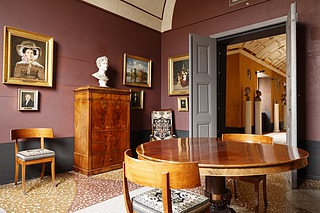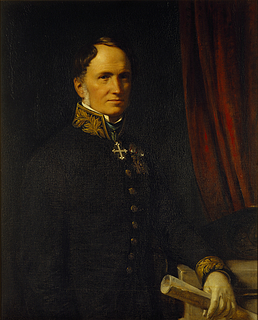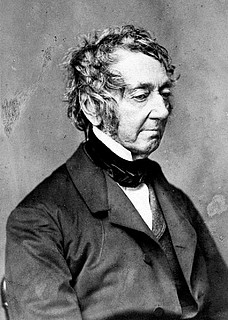At Home in Rome: Competing Ideas of Home and At-Homeness in the Memorial Living Room at Thorvaldsens Museum
- Karen Benedicte Busk-Jepsen, arkivet.thorvaldsensmuseum.dk, 2015
At Home in Rome: Competing Ideas of Home and At-Homeness in the Memorial Living Room at Thorvaldsens Museum
A talk held at the Istituto Svedese di Studi Classici a Roma for the conference Another Horizon. Northern Painters in Rome and Naples 1814–1870, October 20th, 2015
What is a home? What is it like to be at home? And where is your home? Would that be in your fatherland where your mother tongue is heard and spoken, or could it be in a place that is foreign altogether? This question is as topical now as it was 200 years ago. In this short paper, I will discuss two competing ideas of home and at-homeness at work at the Thorvaldsens Museum in Copenhagen. My empirical point of departure is a painting from 1819, which was assigned to the museum in 1905: namely, the German painter Louise Seidler’s (1786-1866) portrait of her friend, the German actress Franziska Caspers (1787-1835), which conveys, as we shall see, an idea of Rome as a spiritual home. The competing idea of home that I will be taking up afterwards unfolds itself in that painting’s current location on Thorvaldsens Museum’s first floor. This is the museum’s memorial living room, which was arranged in order to convey an entirely different idea of home, namely, that of the nation as one’s rightful home—an idea that, as we know, gained momentum in the 1820s and 1830s, and eventually took over in practically all of Europe. I am going to dwell on the tension between those two ideas of home. Also, I will discuss whether the national agendas at work when Bertel Thorvaldsen (1770-1844) came “home” in order to spend the last part of his life in Denmark may block our view of an earlier time—a time more cosmopolitan and less national—of which he could be said to be a child. 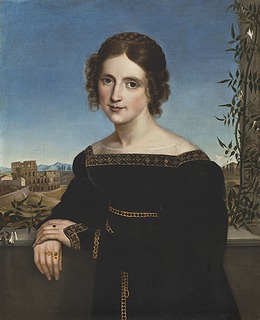
Louise Seidler (1786-1866): Portrait of Franziska Caspers, 1819, oil on canvas, 74×60,5 cm, Thorvaldsens Museum, Copenhagen.
I will begin by taking a close look at Seidler’s Portrait of Franziska Caspers with a specific view to the relation between the sitter and the location. As we see, Caspers is depicted standing in a loggia that overlooks a cityscape of Rome, looking toward the viewer with an open, yet slightly inward and dreamy gaze. While her body language is carefully arranged, it still conveys a state of relaxation, as she rests her right arm comfortably on the loggia wall. The calm and peacefulness of Caspers’ appearance corresponds with the calm blue sky behind her, which gradually fades into light blue at the horizon. Similarly, the simple and balanced composition of the Roman cityscape behind her, with the Colosseum to the left and—probably—the round church of San Stefano Rotondo far away to the right, further adds to the viewer’s experience of composedness. It goes without saying that this portrait recalls Renaissance portraiture. What is more, and a bit at odds with her typical early 18th Century hairdo, Caspers wears an exquisite black Renaissance dress with pointy sleeves, golden chains and a highlighted neckline. The inspiration from painters like Raphael seems obvious: One could take as an example the Portrait of Elisabetta Gonzaga of Urbino (c. 1504-1505), which shows the serene duchess of Urbino clad in a black dress with a pattern of golden rectangles, gold chains around her neck, in front of a calm rural landscape.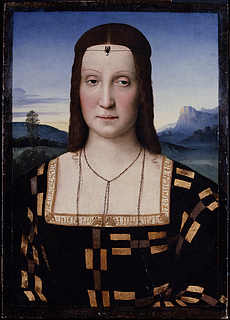
Attributed to Raphael (1483-1520): Portrait of Elisabetta Gonzaga of Urbino, c. 1504-05, 52×37,3 cm, Galleria degli Uffizi, Florence.
By rendering Caspers in line with a Renaissance noble who would be understood, naturally, as belonging to the landscape behind him or her through kinship, marriage, or fortune, Seidler implies that Caspers is just as much at home in Rome as Elisabetta Gonzaga was at home in the Duchy of Urbino. In this way, by using a familiar scheme, Seidler conveys the impression of Caspers as belonging naturally to Rome. But this is 1819, and Caspers was neither a native nor a resident of Rome. She was an educated German woman from the city of Mannheim, a former actress at the Weimarer Hoftheater, and a lady’s companion to a Hungarian princess, Maria Leopoldina Grassalkovich (1776-1864), who went to Rome for months at a time. The key to Caspers’ specific way of belonging to Rome may be found in her dreamy gaze, taken together with the ancient buildings behind her: Caspers is at home in Rome in that she spontaneously dwells on the eternal city’s glorious past, represented by a first-century amphitheater and a fifth-century church. I cannot help but add, on a biographical note, that Caspers wrote enthusiastically and refinedly about her experiences of Roman art and architecture, and in a letter to her friend Charlotte Thierry of March 16th, 1819, she mentions a night excursion to the Colosseum:
“I spent the evening with several of the artists here at my friend Louise Seidler’s place—at nine thirty, we made the decision to experience the beautiful full moon in the Colosseum. … What can I tell you of the Colosseum in this magical lighting that you have not seen for yourself—it was a night like the one we spent there—and the beautiful memory enhanced the beautiful present.”
It appears that Caspers was fond of contemplating the Colosseum, not least by the light of the full moon, so there was a clear reason for letting that exact building appear behind her on the portrait. Apparently, Thorvaldsen, who was a close friend of both Caspers and Seidler and came by many times when Caspers was sitting, contributed to the choice of building, prompting another close friend of Seidler, the Swiss painter Johann Caspar Schinz (1797-1832), to make a preparatory sketch of the Colosseum for the background.
Johann Heinrich Wilhelm Tischbein: Goethe in the Roman Campagna, 1787, oil on canvas, 164×206 cm, Städelches Kunstinstitut und Galerie, Frankfurt am Main.
In terms of belonging to Rome, it is tempting to draw a parallel to the German painter Johann H. W. Tischbein’s (1751-1828) famous Goethe in the Roman Campagna from 1787, not least because the idea of a merger with the Roman landscape is taken to the extreme in this case. Here, the sitter has brought himself into close physical contact with the landscape and its ruins; he seems to feel completely at ease resting with his entire lower body and his right forearm on the hard blocks of stone, as he gazes intensely into infinity. There can be no doubt here, neither, that Goethe belongs to the Roman campagna. As it turns out, Goethe is relevant to touch upon in this context also for the reason that he—like Thorvaldsen—was closely connected to both Caspers and Seidler. He admired Caspers’ acting at the Weimarer Hoftheater, and he supported Seidler and corresponded with her.
Regarding Seidler, she grew up in Jena, next door to Goethe, and decided to become a painter when she visited the Dresden Gemäldegalerie after her husband’s untimely death. While it is true that women were practically never admitted at the art academies then, there are nonetheless many examples of women artists who found alternative ways of educating themselves. Seidler took private lessons with Christian Leberecht Vogel (1759-1816) and Gerhard von Kügelgen (1772-1820), and, in 1817, by way of a stipend from the Grand Duke of Sachsen-Weimar-Eisenach, she exceptionally gained access to the Academy of Fine Arts in Munich. The following year, 1818, she continued to Rome, where she lived and worked in the German artists’ colony at Monte Pincio. It was also in Rome that she, as chance would have it, met her old schoolfriend Franziska; the two of them had gone to a progressive school for young women in Gotha, and they reconnected in Rome. As such, the Caspers portrait is a Freundschaftsbild, yet no informal keepsake. Seidler eventually picked it out for a show of German artists in the Palazzo Caffarelli in 1819.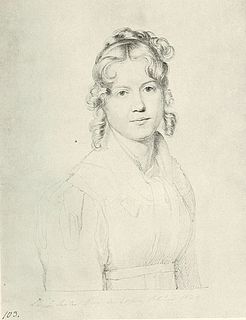
Carl Christian Vogel von Vogelstein (1788-1868): Louise Seidler in Rom, 1820, pen on paper, Staatliche Kunstsammlungen Dresden, Kupferstich-Kabinett.
Before I turn to the memorial room at Thorvaldsens Museum, where Caspers’ portrait is situated among many other objects, I would like to invite you to imagine a home that is long gone and of which no visual representations remain—namely, Thorvaldsen’s apartment in the boarding house Casa Buti in the Via Sistina, which he occupied for as long as 38 years. Fortunately, a few descriptions survive, and it seems quite appropriate in this connection to quote precisely Seidler’s description from around 1820. In her posthumous memoirs, Seidler observes that her friend Thorvaldsen disposed of three rooms:
“In the first [room] there was a small studio, where easels with unfinished bas-reliefs were standing all around; the floor, the tables, and the chairs were covered with small figures; it was a bother to find a chair to sit on, nothing came close to comfort anywhere … The bedroom was particularly small; but nonetheless, hard by the artist’s bed stood a modeling chair with an unfinished work, where he used to work right after he rose. Behind this room was a somewhat larger room adorned with paintings that Thorvaldsen had bought to support hard-pressed artists; on the tables sat all kinds of archaeological finds, vases, coins, bronzes, etc., in a motley disorder.”
A motley disorder. Seidler describes Thorvaldsen’s home as packed, unaccommodating, and colorfully messy. It was clearly not arranged in order to be presentable or inviting, but in order to function as a place to sleep, work, and store things for somebody who worked most of his waking hours—rather than a place to socialize in or to show off. Seidler was not alone in finding Thorvaldsen’s home surprisingly modest. Both his main biographer, Just Mathias Thiele (1795-1874), and the Danish writer F. C. Hillerup (1793-1861) voice a similar surprise in their accounts of 1824 and 1829, respectively. As Hillerup writes: “While many other artists of a little renown in the world live as princes and counts, he who outshines them all by the radiance of his immortal name lives in unassuming simplicity.”
Now, for the sake of contrast, I would like to jump to the memorial living room at the Thorvaldsens Museum, which allegedly presents Thorvaldsen’s Danish home. This room holds an exquisite selection of furniture: A large wooden sofa and several Klismos chairs are arranged around a big coffee table, and the room has a writing desk, a long-case clock, a chest of drawers, and an easy chair, while the walls are decorated with paintings in golden frames. The arrangement comes across as select, elegant, orderly, and airy, and the many seats seem to invite the visitor to sit down for a cultured chat and a cup of tea.
Thorvaldsen’s memorial living room (Room 22) as of October 2015, Thorvaldsens Museum, Copenhagen.
It is as yet unclear when exactly this kind of arrangement was installed at the museum for the first time, but a photo, which probably dates from between 1875 and 1900, attests to an early version (Room 42). The memorial living room was reinstalled at least one more time in a different room (Room 32), before it was installed in its current location in the room at the museum that comes prior to Thorvaldsen’s collection of paintings (Room 22).
Thorvaldsen had practically no share in the furnishing of the memorial living room, however. As it turns out, the furniture was selected for him by his Danish friends, and a circle of Copenhagen women had been so kind as to embroider the upholsteries for the furnished professor’s apartment that awaited him at the Royal Danish Academy of Art when he moved to Copenhagen in 1838. We don’t know which paintings were hung on the walls of that apartment, but the paintings on the walls of the current memorial living room almost univocally celebrate Thorvaldsen’s descent and his Danish circle of friends.
Several paintings in the living room depict memorable Danish locations in the sculptor’s life such as Carl Dahl’s rendering of Larsens Plads (1840), B207, at Copenhagen’s harbour, where Thorvaldsen’s father worked as a woodcarver, and Heinrich Buntzen’s representation of the manor house Nysø on Southern Zealand, Nysø Manor with Thorvaldsen in front of his Studio (1843), B203, where Thorvaldsen spent an important part of his last six years in Denmark. Others are portraits by Danish painters of some of Thorvaldsen’s important Danish friends and acquaintances, such as that of his benefactor Christine Stampe by C.A. Jensen from 1827, B432, that of his biographer Just Mathias Thiele (year unknown) by Wilhelm Marstrand, B421, and the 1841 portrait by Emil Bærentzen of Thorvaldsen’s favored actress at the Royal Danish Theatre, Johanne Luise Heiberg, B205.
Wilhelm Marstrand: Portrait of Just Mathias Thiele, year unknown, oil on canvas, Thorvaldsens Museum, Copenhagen. Hung in the memorial living room as of 2015.
I may be stating the obvious here, but what I am getting at is the fact that Thorvaldsen’s memorial living room is a constructed place that follows a Biedermeier idea of at-homeness, where the ideal home is a conventionally beautiful and orderly place to seek comfort in, situated, in a wider sense, in the safe lap of the nation. With Seidler’s impression of the motley disorder in Thorvaldsen’s Roman home in the back of one’s mind, the contrast is striking. When Thorvaldsen chose for himself, he did not design his home in accordance with Biedermeier aesthetics, nor did he socialize exclusively with his compatriots, for that matter. Quite the contrary. Nonetheless, the only painting in the memorial living room that clearly reveals that Thorvaldsen was also acquainted with people of non-Danish descent—at least in the current version of the room—is Seidler’s portrait of Caspers, which was assigned to the museum in 1905.
Within the logic of the Biedermeier home, Caspers could be seen as a stand-in for the wife that Thorvaldsen never had; and almost all that has been written on Seidler’s painting in a Danish context has focused on the short love story between Thorvaldsen and Caspers in 1818-1819. I have willingly avoided that focus in order to regard the painting in its own right, and to look into the idea of home and at-homeness that it conveys—an idea that Thorvaldsen most probably identified with more than he did with that conveyed by a quaint Biedermeier home stripped almost of all signs of the world outside Denmark.
What I have tried to shed light on in this talk are the two competing ideas of home and at-homeness that are at work in Thorvaldsen’s memorial living room. On the one hand, the idea of Rome as a spiritual home that emanates from Seidler’s portrait of Caspers, which is revealing of her as an individual, but also, more generally, of a certain way of relating to Rome in an early nineteenth-century cosmopolitan environment, of which Thorvaldsen was a part. This contrasts with the dominant idea of home as conveyed by the memorial living room, which reflects a conventional idea of the nation as one’s home and one’s compatriots as one’s natural circle of friends. By demonstrating this tension, I have tried to show that the late nineteenth-century casting of Thorvaldsen as Danish first and foremost that, exemplified in the memorial living room, may still hinder our access to the era of “cosmopolitan Romanticism,” to use a term that Martin Olin coined yesterday, that preceded the era of nationalisms, and of which Thorvaldsen was importantly a child.
Budtz Müller & Co.: Portrait of Carsten Hauch, 1868 (?), photo, section, The Royal Library, Copenhagen
One should of course beware the danger of romanticizing the time before the entry of the nationalisms; and also beware the risk of generalizing too much from a figure as generally admired and settled in Rome as Thorvaldsen. All the same, when you look upon his acquaintances in Rome, it is obvious that he did not just stick to his fellow countrymen; his circle of acquaintances was a very mixed one in terms of nationality, composed of people of German, Polish, Danish, Swedish, British, Italian, and many other descents. Nationality simply did not seem to be an issue—and neither did sex, by the way.
But things change, and I would like to end with a quotation by one of Thorvaldsen’s friends, the Danish poet Carsten Hauch (1790-1872). In his memories, Hauch describes the way in which people socialized at the Caffè Greco and beyond, with a common focus on the arts: “As long as people sympathized artistically, they cared little about anybody’s descent.” Art “united people,” he writes, “like an ocean current which carries everybody away, so nationality, however highly you loved your country, never led to any sharp divisions.” Hauch, however, was looking back in 1871, sadly aware of the wars between the nations that had driven a wedge between people since. “When you think back, it is as if you looked at a time so different from now that you would think centuries had passed.” At that point, Rome was no longer, as Hauch puts it, “a peaceful home.”
Referencer
- Carsten Hauch: ‘Caffè Greco’ in: Danmark Italia, Hellerup 1996, s. 74-77.
- Carsten Hauch: Minder fra min første Udenlandsreise, København 1871.
- F.C. Hillerup: Italica eller Mindeblomster fra mit Ophold i Italien, København 1829, vol. 2, p. 96-97.
- J.M. Thiele: Den danske Billedhugger Bertel Thorvaldsen og hans Værker, Anden Deel, tekst- og planchebind, København 1832.
- Hermann Uhde (ed.): Erinnerungen und Leben der Malerin Louise Seidler (geboren zu Jena 1786, gestorben zu Weimar 1866), Berlin 1874.
Sidst opdateret 25.05.2018


